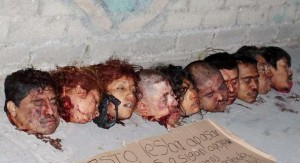With a loving mind, cherish more than a child the hostile gods and demons of apparent existence, and tenderly surround yourself with them. Nourish them always with warm flesh and blood. with the hook of love and compassion, befriend them and never dismiss them.
If, with pure noble thought and enlightened resolve, you connect them to the sacred Dharma and they are freed and established in happiness, then you, child, whoever you are, will be my inseparable friend.
– from the teachings of Machig Labdron
J.F. Martel, author of the upcoming Evolver Editions book Reclaiming Art in the Age of Artifice, sent me a note this morning asking if I had seen an academic paper on Santa Muerte that was recently posted to Academia.edu. The paper is titled: Making a Life out of the Worship of Death: a psychodynamic and phenomenological ethnography of La Santa Muerte in Estado de México, and it is presented by Wendy Risteska, a PhD Candidate at the University of Sydney.

“They estimate the ages of the dead to be 20-35 years. It was not reported if the heads of two missing Teloloapan police were among those in the gruesome display.
The area is in contention between The Familia Michoacán and their offshoot The Knights Templar resulting in ongoing violence and conflict.
As of late this afternoon the severed bodies had not been located despite extensive area search by three government police agencies.”
The world in which Santa Muerte exists is not some scholarly vacuum of archetypes and weighted words – she oversees the terror and blood that fills the streets, standing with hollow eyes she stares through the illusions that cover the conflict. All are equal beneath her scythe as she looks upon the madness, pain, confusion, and fear that haunt the shadows of supposed civilization.
Since moving to rural Georgia nearly a year ago, I’ve been unable to avoid these realities – not the sparkling affluent consciousness culture illusion – the raw, unflinching realities of life in the United States. My exploration of Santa Muerte’s tradition had already opened my eyes to the very real violence of our contemporary world, but this year has given me more of my own personal experiences that have opened up a vision for the dangerous realities of the 21st century. Most prevalent in this has been being sucked into Georgia’s prison industrial complex a few months ago due to some confusion over paper work at the DMV.
Today, as I type this, I am due to appear at the Madison County courthouse to face the repercussions of seeking quietude in a forest. Falling away from society, losing sight of money and the mechanics of bureaucracy, a police road block one Sunday morning in rural Georgia awoke me to the fact that I seem to have forgotten the implicit power crawling behind our culture’s ardent belief in bureaucratic forms.
At the moment I am two hours away from Madison County, my car is dead, and I have no way of traveling to meet the scheduled appointment with the court. Having enjoyed a year in the woods, I wait now under the shadow of a warrant that will be issued for my arrest and the arrival of a bail bondsman sometime next week when the legal machine signals that I have not made my proper appearance before the judge – all over some paperwork.
The bondsman will make the two hour trip to secure his money – though I imagine he would not do the same to help me make my meeting in court. We had a pleasant chat while filling out paperwork when I was released from jail – he works late hours and focuses most of his life on his job and staying fit because, in general, he dislikes people. Curt, but not cruel, he has dealt with the justice system long enough to only show surprise when there is no ulterior motive in a person’s actions. I imagine he likes cars, but is not as interested in dealing with the mechanics.
–
You cannot stand half-in and half-out of the machine without some friction. It was a fax for an address change that never made it to the Department of Motor Vehicles, or the requirement for a bodily person at the DMV office to complete the change, with no phone, no steady web connection and away in the woods I can’t know for certain what caused the confusion – only the aftermath of looking into the cold eyes of a county sheriff accompanying his request that I step out of the vehicle.
On the way to Madison County jail, the radio in the sheriff’s car sent an ominous message as two sportscasters lauded the death of sportsmanship – “Remember back when he used to ask the other coach what players were injured, and he would tell his team not to hit them there…what a joke, that’s not how you win.”
–
In a previous piece I described some of my experience in jail after my initial arrest (Click Here to read It All Depends on What You Call a Guru), where I met a fellow who had just had a near death experience involving Santa Muerte (Saint Death) – whose domain is the weary world of the liminal and dispossessed. If you’ve never been in a jail cell – with no hope of getting out – that timelessness of cinder block walls and a steel bed – it’s hard to describe why she is so beautiful, why her devotees call her la Nina Bonita, the Beautiful Girl.
While my cell mate related the impression left by her ties to narco-culture that he had garnered from media reports, what I saw was something quite different. He admitted that he needed to be in jail, it was his only way out of a lifestyle of violence and addiction. If he wasn’t here, he said, he would probably be dead by the way things were going when he was arrested. Her presence in his life preceded his admitted salvation, and in Mexico she is known for as a healer specializing in curing addiction. Looking into his eyes as he spoke of his life, his love of his family, I couldn’t help but notice how different, how humane he was in stark contrast to the cold eyed sheriff who had arrested me without a sign of regret over some paperwork, or the dull eyed and fearfully fidgeting guards who shuffled me from station to station through the jail.
Being put in population was a relief after spending hours alone in a holding cell with no contact outside of brief checks from unresponsive jailers. This is something that is missed in any academic conversation about criminality, narco-culture or cultures of illegality. Because such conversations are had from the safety of colleges and universities, or from the alienating position of ‘ethnographer,’ ‘researcher’ or ‘specialist’ at no point do they access the fact that Santa Muerte exists outside of a theoretical structure. As a patron of the margins she exists where official figures and authorities are often engaged not as a help, but as a hindrance or worse as a direct threat.

It’s true that there is also the chance that the blockade was set up to stop drug trafficking, as rural Georgia is known for issues with methamphetamine and the like. Yet, I found getting to know my cell mates in jail, as well as in living in the area, that the drug problem is related directly to the lack of social and cultural infrastructure, leadership and education in the areas that it manifests. The problems are supported by the same mindset that leads to a myopic obsession with paperwork and the kind of thoughtless transference of guilt where a person can be put in a position of being jailed for two months awaiting a court date for a misdemeanor. Along the borders of Mexico, where Santa Muerte finds many devotees, the realities of this “drug problem” are painted in blood and violence, in dismembered bodies and mass graves.
One of my cell mates was functionally illiterate – when the fellow who had the experience with Santa Muerte related his appreciation of the Christian Bible the other cell mate said simply “I never read it, can’t really read.” Which lead to an offer to help him learn. How effective do we imagine social programs will be when they are designed by academics for a population that is functionally illiterate? One can be savvy to other ways of experiencing the world than the written word, but this creates a communication gap that can’t be bridged from behind a desk while assembling a slick powerpoint to impress state agencies.

When I see scholarship on Santa Muerte seeking to define her while avoiding the fact that she emerges from the grounds of a society faced with brutal, militarized and corrupt police allied with corrupt politicians and drug czars, fostered by social complexes that profit on the chaos running rampant over a society – a world of kidnappings, decapitations, literal human sacrifices in the streets – and the fact that those in the raw heat of the thing are now turning to a spiritualized figure of holy death as an integral part of their relationship with reality – I’m not sure what good skewed scholarship can do outside of playing to an overstimulated conceptual sense and further distancing us from some deeper realization that might stave off some of the corruption.
The truth of illusion is that there is always a truth beneath the facade – and that truth will emerge in one way or another despite the best efforts to avoid it or look away. Just as the social realities of Santa Muerte’s emergence can be hidden behind psychobabble – they can be hidden behind ideas of “criminality” and “cultures of illegality” – at the end of the day there are still decapitated heads and the violence of our species still rages unchecked around the globe. Even if our avoidance is merely out of habitual politeness, attitudes of distaste or a hope that “everything will be ok in the end…” – there are still dead bodies and blood stains on the concrete.
If we can face this violence without seeking some kind of false solace, maybe some day we can find the peace that the Tantric adept Machig Labdron speaks of when she says:
“If, with pure noble thought and enlightened resolve, you connect (the hostile gods and demons) to the sacred Dharma and they are freed and established in happiness, then you, child, whoever you are, will be my inseparable friend.”
In the mean time, I’ll await the knock of the bail bondsman and a pending warrant to take me deeper into the world of those who find hope in the arms of Saint Death.
“Until the miserable wailing of the suffering of all beings ceases, the illness of the Bodhisattva is never cured.”
–
For further thoughts on facing the visceral truth see – Dedicated to a dead dog… a Christmas time memory of senseless violence and the the meditative value of composting bodies.
For more on Santa Muerte – visit SkeletonSaint.com where Dr. Andrew Chesnut and I are working to explore this explosive devotional tradition as it travels around the globe.
–
Image credits – Borderland Beat, except the image of the creek, which was captured during a meditative walk in Loganville, Georgia.















